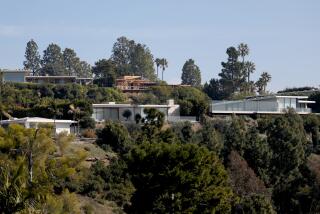Resident ‘stars’ take a walk down memory lane at ‘History of Beverly Hills’ premiere
Days before a new movie premiered last week in Beverly Hills, organizers announced that there were no more tickets to be had. Long lines formed before the screening, even though it was a weeknight.
Some people dressed elegantly for the event at the gleaming Wallis Annenberg Center for the Performing Arts. A few women wore fur.
That they wanted to look their best was only natural. They were among the movie’s bevy of stars.
Well over 100 Beverly Hills residents had helped in the making of “The History of Beverly Hills: 100 Years, 100 Stories” by sharing their memories with homegrown filmmaker Phil Savenick.
They’d talked about the way the city used to smell when the Wonder Bread factory did its baking at night.
They’d remembered the thrill of being children and filling their cups from the magic (papier-mache) lemonade tree at Uncle Bernie’s Toy Menagerie.
Those who were old enough had reminisced about riding to friends’ houses on the bridle paths that, into the 1960s, ran through the middle of several city streets.
Join the conversation on Facebook >>
Savenick, who proudly wore his 1969 Beverly Hills High School varsity jacket to the premiere, said those were the kind of details he’d hoped for when he began collecting tales for a film to mark the city’s 2014 centennial.
“The real story is, we’re more than three blocks,” he said — referring to Rodeo Drive. “Why are we famous? Not because of the shops.”
The prospect of watching 90 minutes of municipal memories might not draw a crowd in your average American city.
But Beverly Hills — with 34,000 people living in 5.7 square miles — isn’t average.
This movie’s stars spoke of the celebrities with whom they’d grown up having everyday encounters.
They’d trick-or-treated at Lucille Ball’s house on Roxbury Drive, bumped into Debbie Reynolds at the market, watched Fred Astaire float down a sidewalk as gracefully as if he were dancing.
NEWSLETTER: Get the day’s top headlines from Times Editor Davan Maharaj >>
He really did dance in town sometimes, said Savenick, who is president of the Beverly Hills Historical Society. Astaire used to drive in his Rolls Royce to the post office, the building that now houses the performing arts center.
While waiting for his mail, he’d “tap dance on the terrazzo floor,” Savenick said.
“The History of Beverly Hills” — bits and pieces of which can be found online — features many a star turn via old photos and film clips.
There’s Will Rogers in 1926 in front of the Beverly Hills Hotel (which after his death named its Polo Lounge in his honor), accepting his surprise, tongue-in-cheek elevation to honorary mayor of the city. “We’ve roped him,” reads a sign in the crowd.
There’s Ball, speaking before the City Council about the buses that used to dump tourists on her block and how she’d regularly find them spreading out their lunches on her front lawn.
When she expressed her frustration to neighbor Jimmy Stewart and asked how he managed it, she said, he told her he quietly went around the back and turned on the sprinklers.
The movie, partially funded by the city, is full of civic pride.
There’s a bit, for instance, about the often-forgotten original opening to resident Irving Berlin’s “White Christmas.” (“The sun is shining, the grass is green/The orange and palm trees sway/There’s never been such a day/In Beverly Hills, L.A.”)
But it also pokes plenty of lighthearted fun at the city and its international reputation.
In a 1956 clip from “The Jack Benny Program,” the comedian who lived on Roxbury Drive pretends he’s reporting his stolen car to the Beverly Hills Police Department. Seated behind a velvet rope, under a chandelier, a receptionist asks him: “Do you have an appointment?” and “Who recommended us?”
Residents crack their own jokes too.
“Sometimes I say it reminds me of ‘Mayberry R.F.D.,’ with maybe a little Botox and lip gloss on it,” Myra Lurie, a former school board president, said of her city.
Some admitted to hedging when asked where they live. In order not to be typecast, they said, they stick with a vague “West L.A.”
“The world thinks that we’re all driving diamond-encrusted Rolls-Royces and getting into car accidents with Lindsay Lohan,” Thomas Pease said.
Savenick tried to fit as many voices into the film as he could — each one, he said, “a brushstroke” in his painting of the city.
Their faces and names float by as the movie traces Beverly Hills’ history from the days of the native Tongva Indians, grazing cattle and lima-bean fields all the way to the present.
In the audience, people clapped when they saw familiar faces on the screen: neighbors, former mayors, favorite teachers at Beverly Hills High. They nudged each other or said out loud, “There’s Dad,” or “Look, it’s Nancy.”
The film makes the point that Beverly Hills today is much bigger than the village many grew up in.
But in the dark, as that village filled the screen, the feeling in the room was strictly small town.
Twitter: @latimescitybeat
ALSO
How an anonymous blogger stands out on California water policy
Column: In the state budget, too many good programs can sometimes be bad
As Powerball jackpot continues to swell, ‘everyone wants a piece’ of $1.3-billion prize
More to Read
Start your day right
Sign up for Essential California for news, features and recommendations from the L.A. Times and beyond in your inbox six days a week.
You may occasionally receive promotional content from the Los Angeles Times.







